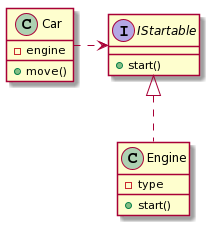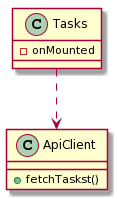SOLID原則に出てくるDI(依存性の注入)とDIP(依存関係の逆転の原則)を勉強したので、自分なりにVue Composition API + TypeScriptでのコンポーネント設計に応用してみました。
🛠 DI, DIPとは?
最初にサンプルコードを元にDI(依存性の注入)とDIP(依存関係の逆転の原則)を復習します。
既にDI, DIPを知っている方はスキップしてこちらへ。
以下Engineクラスに依存するCarクラスをDI, DIPを用いてリファクタリングしていきます。
class Car {
private engine: Engine;
constructor(private type: string) {
this.engine = new Engine(type);
}
move() {
this.engine.start();
// ..処理
}
}
class Engine {
constructor(public type: string) {}
start() {
// ..処理
}
}
const car = new Car("Honda");
car.move();
CarクラスはEngineクラスをconstructor内でnewしています。そして、moveメソッドでCarクラスのstartメソッドを実行しています。
つまり、Carクラスのconstructor、moveメソッドはEngineクラスに深く依存しています。
この状態でCarクラスをユニットテストしようと思っても、内部でnewするEngineクラスの実装に影響されてしまいます。
DI(依存性の注入)
DIはDependency injection の略で日本語では依存性の注入といいます。
内部で使用するクラス(依存するクラス)を内部でnewするのではなく、クラスの初期化時に引数で渡す(注入する)。これがDIです。
DIをすることで
・ソフトウェアの階層をきれいに分離した設計が容易になる
・コードが簡素になり、開発期間が短くなる
・テストが容易になり、「テスト・ファースト」による開発スタイルを取りやすくなる
などのメリットがあります。
サンプルコードを、Carクラスのコンストラクタ内でEngineをnewするのではなく、EngineクラスのインスタンスをCarクラスの初期化時に渡すように修正します。
class Car {
// 初期化時に引数としてEngineのインスタンスを受け取る
constructor(private engine: Engine) {}
move() {
this.engine.start();
// ..処理
}
}
class Engine {
constructor(public type: string) {}
start() {
// ..処理
}
}
const engine = new Engine("Honda");
// CarクラスにEngineのインスタンスを注入している
const car = new Car(engine);
car.move();
こうすることで、依存するEngineを初期化時に動的に差し替えられるようになります。
Carクラスのユニットテストの際に、Engineをモックに差し替えるなども容易です。
ただ、まだCarクラスはEngineに依存している状態に変わりはありません。
DIP(依存関係の逆転の原則)
DIPはDependency inversion principle の略で日本語では依存関係逆転の原則といいます。
DIPの定義は以下の通りです。
1 上位レベルのモジュールは下位レベルのモジュールに依存すべきではない。両方とも抽象(abstractions)に依存すべきである。
2. 抽象は詳細に依存してはならない。詳細が抽象に依存すべきである。
CarクラスはDIでEngineクラスへの依存を注入しているものの、まだCarが引数として定義している型はEngineクラスで具象に依存しています。
これではDIPを守れていないので、IStartableというインタフェース(抽象)を定義し、Carのコンストラクタの引数をIStartableに変更します。
interface IStartable {
start: () => void;
}
class Car {
constructor(private engine: IStartable) {}
move() {
this.engine.start();
// ..処理
}
}
class Engine implements IStartable {
constructor(public type: string) {}
start() {
// ..処理
}
}
const engine = new Engine("Honda");
const car = new Car(engine);
car.move();
Carクラスは具象クラスのEngineに依存せず、抽象クラスのIStartableへ依存するようになりました。
また、Engine自体もIstartableをimplementsすることで、IStartableへ依存するようになりました。
これでCarクラスをDIPに実装できました ![]()
🛠 Vue Composition API + TypeScriptでの実践
さてここからが本題。
DI, DIPをVue Composition API + TypeScriptで実践していきます。
まず、リファクタリング対象となるサンプルコードです。
TasksコンポーネントはsetupのタイミングでApiClientクラスをnewして、onMountedのタイミングでタスク一覧を取得しています。
import { Task } from "@/types/type";
import axios, { AxiosInstance } from "axios";
export class ApiClient {
client: AxiosInstance
constructor() {
this.client = axios.create({
baseURL: 'https://example.com/api/v1',
headers: {'X-Custom-Header': 'foobar'}
})
}
async fetchTasks() {
const { data } = await this.client.get<Task[]>('/tasks');
return data;
}
}
<template>
<div>
<div v-for="task in tasks" :key="task.id" class="task">
<h2>{{ task.title }}</h2>
<p>{{ task.note }}</p>
</div>
</div>
</template>
<script lang="ts">
import { defineComponent, ref, onMounted } from "@vue/composition-api";
import { Task } from "@/types/type";
import { ApiClient } from "@/apis/apiClient";
export default defineComponent({
setup() {
const client = new ApiClient();
const tasks = ref<Task[]>([]);
onMounted(async () => {
try {
tasks.value = await client.fetchTasks();
} catch (e) {
console.log(e);
}
});
return {
tasks
};
}
});
</script>
この状態では先ほど説明したCarクラスの最初の状態と同じく、このTasksコンポーネントはApiClientクラスに密に結合しています。
そのため、急にAPiクライアントを差し替えることになった場合など、Tasks.vueに変更が必要です。
provide/injectでDI(依存性の注入)
Tasks.vueのApiClientへの依存を弱くするため、DIを使います。
Vue-Composition-APIでのDIはprovide/injectを使います。
APIの詳細は公式APIリファレンスのDependency Injection を参照してください。
役割的にはVue2系のprovide/injectと変わりません。
まず、Vueインスタンスをマウントするエントリーファイルのmain.tsで、ApiClientをprovideします。
また、provideにはキーが必要なので、ApiClientで新たに作成しexportするようにします。
import { Task } from "@/types/type";
import axios, { AxiosInstance } from "axios";
export const DefaultApiClient = Symbol("api")
export class ApiClient {
client: AxiosInstance
constructor() {
this.client = axios.create({
baseURL: 'https://example.com/api/v1',
headers: {'X-Custom-Header': 'foobar'}
})
}
async fetchTasks() {
const { data } = await this.client.get<Task[]>('/tasks');
return data;
}
}
import Vue from "vue";
import App from "./App.vue";
import VueCompositionApi, { provide } from "@vue/composition-api";
import { ApiClient, DefaultApiClient } from "./apis/apiClient";
Vue.use(VueCompositionApi);
Vue.config.productionTip = false;
const apiClient = new ApiClient();
new Vue({
render: h => h(App),
setup() {
provide<ApiClient>(DefaultApiClient, apiClient);
return {};
}
}).$mount("#app");
これでApiClientの注入ができたので、Task.vueでapiClientをinjectで参照するように修正します。
<template>
<div>
<div v-for="task in tasks" :key="task.id" class="task">
<h2>{{ task.title }}</h2>
<p>{{ task.note }}</p>
</div>
</div>
</template>
<script lang="ts">
import { defineComponent, inject, ref, onMounted } from "@vue/composition-api";
import { DefaultApiClient, ApiClient } from "@/apis/apiClient";
import { Task } from "@/types/type";
export default defineComponent({
setup() {
const client = inject<ApiClient>(DefaultApiClient);
// injectの戻り値が T | void のUnion型のため
if (!client) {
throw "provie missing.";
}
const tasks = ref<Task[]>([]);
onMounted(async () => {
try {
tasks.value = await client.fetchTasks();
} catch (e) {
console.log(e);
}
});
return {
tasks
};
}
});
</script>
これでTasks.vueは直接ApiClientをnewすることはなくなり、ApiClientへの依存性を弱められました。
ただ、まだTasks.vueでApiClientの型を参照しているので依存性は残ります。
InterfaceでDIP(依存関係の逆転の原則)
最後にDIPを実践し、Tasks.vueとApiClientの依存関係を改善します。
基本で説明した通り、DIPでは抽象であるインタフェースを定義して、具象クラス同士の結合を避けるのですね。
なので、最初にIApiインタフェースを定義します。
そして、provideのキーもIApiに移動します。
import { Task } from "@/types/type";
export const DefaultApiClient = Symbol("api");
export interface IApi {
fetchTasks: () => Promise<Task[]>;
}
そして、ApiClientはIApiをimplementsするように修正します。
import { IApi } from "@/interfaces/IApi";
import { Task } from "@/types/type";
import axios, { AxiosInstance } from "axios";
export class ApiClient implements IApi {
client: AxiosInstance
constructor() {
this.client = axios.create({
baseURL: 'https://example.com/api/v1',
headers: {'X-Custom-Header': 'foobar'}
})
}
async fetchTasks() {
const { data } = await this.client.get<Task[]>('/tasks');
return data;
}
}
最後にmain.tsと、Tasks.vueをIApiへの依存になるように修正します。
import Vue from "vue";
import App from "./App.vue";
import VueCompositionApi, { provide } from "@vue/composition-api";
import { DefaultApiClient, IApi } from "./interfaces/IApi";
import { ApiClient } from "./apis/apiClient";
Vue.use(VueCompositionApi);
Vue.config.productionTip = false;
const apiClient = new ApiClient();
new Vue({
render: h => h(App),
setup() {
provide<IApi>(DefaultApiClient, apiClient);
return {};
}
}).$mount("#app");
<template>
<div>
<div v-for="task in tasks" :key="task.id" class="task">
<h2>{{ task.title }}</h2>
<p>{{ task.note }}</p>
</div>
</div>
</template>
<script lang="ts">
import { defineComponent, inject, ref, onMounted } from "@vue/composition-api";
import { DefaultApiClient, IApi } from "@/interfaces/IApi";
import { Task } from "@/types/type";
export default defineComponent({
setup() {
const client = inject<IApi>(DefaultApiClient);
// injectの戻り値が T | void のUnion型のため
if (!client) {
throw "provie missing.";
}
const tasks = ref<Task[]>([]);
onMounted(async () => {
try {
tasks.value = await client.fetchTasks();
} catch (e) {
console.log(e);
}
});
return {
tasks
};
}
});
</script>
これでTasks.vueは直接具象クラスのApiClientに依存することはなく、抽象クラス(インタフェース)のIApiへ依存することになりました。 ![]()
🛠活用例
DI、DIPを実践することで疎結合なコンポーネントができたので、この設計がどのように活用できるのか考えてみます。
API差し替えでの活用
この状態であれば突然「Axiosをfetch APIに変更する」となっても、Tasks.vueに変更は不要です。
新しくIApiをimplementsしたfetchApiClient.tsを作成し、main.tsでapiClientと差し替えてprovideすれば完了します。
import {IApi} from "@/interfaces/IApi";
import {Task} from "@/types/type";
export class FetchApiClient implements IApi {
BASE_URL = "https://example.com/api/v1";
async fetchTasks(): Promise<Task[]> {
const response = await fetch(`${this.BASE_URL}/tasks`);
return await response.json();
}
}
import Vue from "vue";
import App from "./App.vue";
import VueCompositionApi, { provide } from "@vue/composition-api";
import { DefaultApiClient, IApi } from "./interfaces/IApi";
import { FetchApiClient } from "@/apis/fetchApiClient";
Vue.use(VueCompositionApi);
Vue.config.productionTip = false;
const apiClient = new FetchApiClient(); // ここでnew ApiClient()と差し替えるだけ
new Vue({
render: h => h(App),
setup() {
provide<IApi>(DefaultApiClient, apiClient);
return {};
}
}).$mount("#app");
コンポーネントのユニットテストでの活用
また、ApiClientとTasksコンポーネントが疎結合となるのでユニットテストも容易になります。
IApiをimplementsしたモッククライアントを作ればAPIクライアントを容易に置き換えられます。
import { createLocalVue, shallowMount } from "@vue/test-utils";
import Tasks from "../../src/components/Tasks.vue";
import VueCompositionApi from "@vue/composition-api";
import { DefaultApiClient, IApi } from "../../src/interfaces/IApi";
const localVue = createLocalVue();
localVue.use(VueCompositionApi);
// IApiを実装したモックのクライアント
class MockClient implements IApi {
async fetchTasks() {
return [
{
id: 1,
title: "買い物",
note: "人参、牛乳",
completed: false
},
{
id: 2,
title: "掃除",
note: "リビング",
completed: false
}
];
}
}
describe("Tasks.vue", () => {
it("タスク一覧を表示する", async () => {
const mockClient = new MockClient();
const wrapper = shallowMount(Tasks, {
localVue,
provide: {
[DefaultApiClient]: mockClient
}
});
await wrapper.vm.$nextTick();
await wrapper.vm.$nextTick();
const tasks = wrapper.findAll(".task");
expect(tasks.length).toBe(2);
expect(tasks.at(1).text()).toContain("掃除");
expect(tasks.at(1).text()).toContain("リビング");
});
});
終わりに
以上、「Vue-Composition-API + TypeScriptで実践するDI(依存性の注入), DIP(依存性逆転の原則)」でした。
正直なところ、設計周りは大の苦手でSOLID原則もまだまだ勉強中です。これで理解が正しいのか自信はないです..。ただ、「記事を書いてマサカリ受けることで、より理解を深められるのでは?」という気持ちで思い切って書いてみました。
指摘、コメント大歓迎です。よろしくお願いします。
参考
以下記事とても参考にさせて頂きました ![]()



